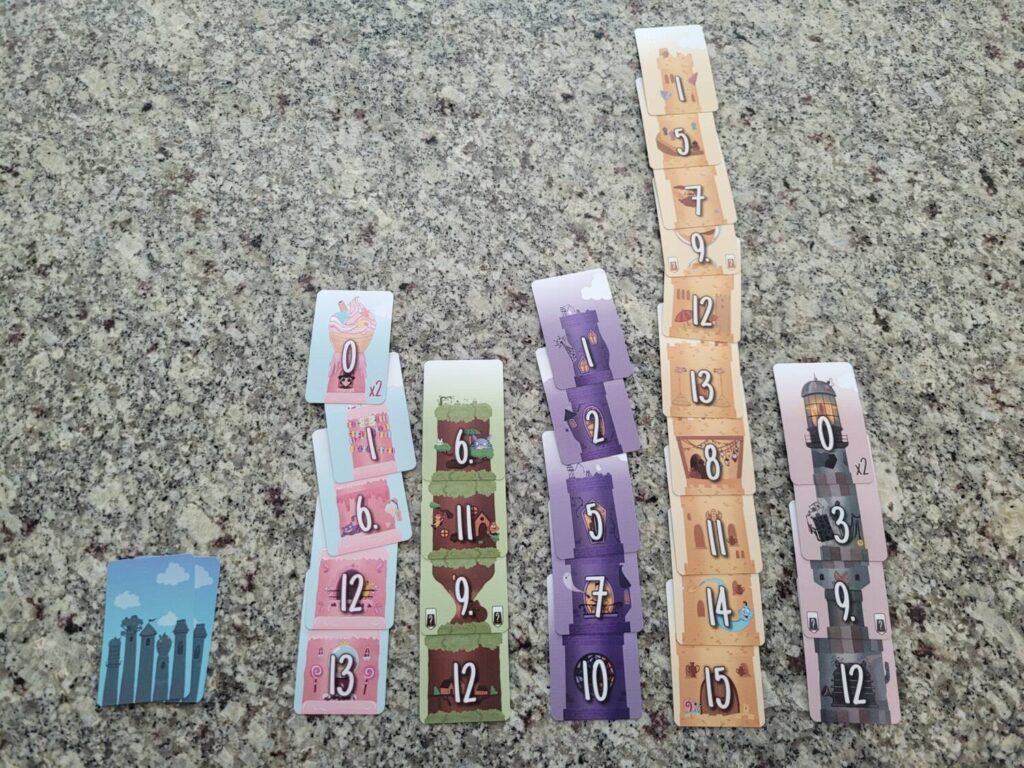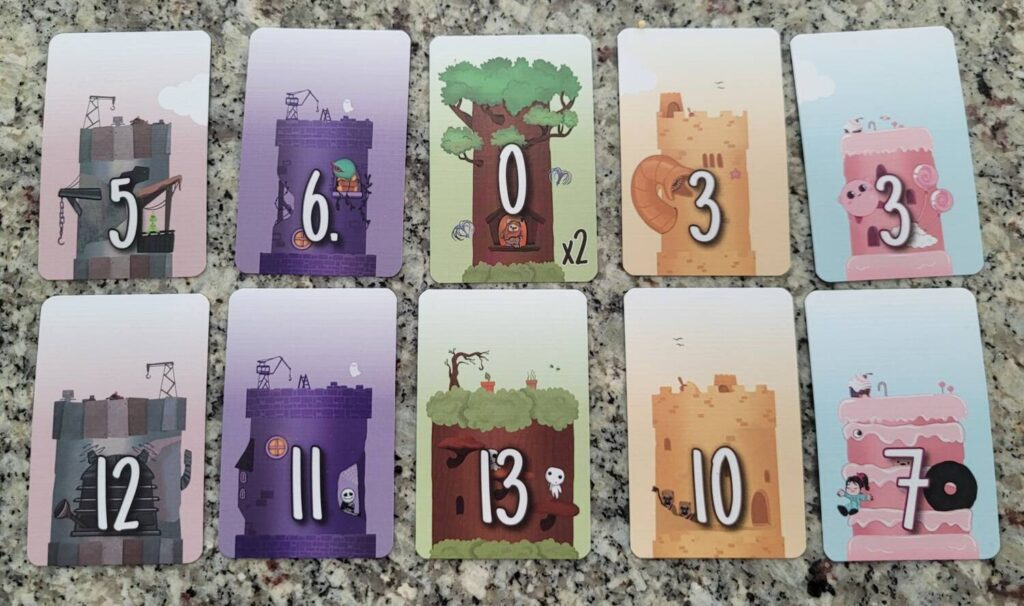If there’s one truth in the world of modern board games, it’s this: the powers that be are constantly putting on ridiculous contests. Whether it’s to see who can become the greatest mage, to determine who can out-merchant everyone else, or, in the case of 5 Towers, to see which architect can build the city’s tallest towers, the powers that be apparently have way too much time (and seemingly endless funds) on their hands.
How to Play 5 Towers
At its heart, 5 Towers is a bidding game. During each round, five cards will be turned face up from a deck for all to see. The starting player will name a number. This number is how many cards that player is willing to take from the display to add to the tableau they will be building in their personal area. Each other player has a chance to up the bid. The tricky part is, if you win the bid, you MUST claim the number of cards that you bid from the display and you MUST add them to your tableau. Any cards not claimed are added to a public discard pile.

Sounds easy enough, right? Not so fast. There are five suits of cards (tower types) and there are sixteen cards per suit, numbered zero through fifteen (there are a few extra cards in 4-5 player games). Each card can only be placed onto a tower of the same kind, and each card placed must be of a value lower than the last card placed into the tower.
The only exceptions to this rule are the numbers eight, nine, and zero. Any number can be placed on top of an eight, and a nine can be placed on top of any number. Zeros top off a tower. Once a zero has been placed onto a tower, that tower can never be manipulated in any way for the remainder of the game.
After the player that wins the bid collects their cards, they have the opportunity to perform a single ‘tear down’ action. Tearing down involves removing the top card from any tower in your tableau (unless the card is a zero) and placing it into a personal discard pile. This is useful for making way for better cards and opportunities. For instance, if you’re stuck with a seven sitting on top of a fifteen, tearing down the seven to replace it with an eleven gives you more opportunities to add onto that tower in future rounds.
At the start of the game, you will choose a starting player. After the end of a round, after the winner has placed their cards into their tableau, the person to the left of whomever the starting player was will become the starting player for the next round. After you’ve cycled through the deck, the public discard pile is shuffled to create a new deck. Once that new deck has been cycled through, the game ends and scores are tallied.
Scoring
Each of your towers scores points equal to the number of cards that are in that tower. If a tower is topped with a zero, the score for that tower is doubled. Then, score one point per card in your tallest tower. After you’ve tallied up this positive score, you’re going to lose points for cards in your tear down pile. The first card is worth -1. The second card is worth -2. The third card is worth -3, and so on.

The player with the highest score wins.
Thoughts
Over the past few years, I have developed an appreciation for small box games that I can shove in my pocket and play over a meal or a lunch break. It’s not that my love of big box euros has waned. It’s that my time to play them has almost entirely evaporated. Between work, marriage, and raising a five-year old, my time is much more limited than it was in the past. My gaming life exists in those moments in-between things.
5 Towers is perfect for this new setup. It fits in my pocket. The rules are simple. The gameplay is challenging, but not so challenging that it takes forever to play. From opening the box to packing it away, I’ve only invested around 20 minutes of my time. And what a glorious 20 minutes it is.
From the very first card draft, 5 Towers faces you with some tough decisions. The entire premise is that you’re building towers to score points. The bigger those towers are, the more points you’ll earn. But, what if you’re just getting started and all the cards that are flipped up are low numbers? Should you pass and let your opponents take their shot at them? Or should you bid at least one knowing that you can always tear it down later? I mean, after all, in order to score points, you have to have built at least something.
In the case of a bunch of low numbers early in the game, the right decision is pretty easy to come by. But, what if there are a bunch of mid-range numbers? What then? And, that doesn’t even take into consideration what the other players might need for their towers. If one of your opponents could claim three of the cards, can you bid three as well? If you’d have to tear down a card in order to do so, just how many points are you willing to bleed in order to deny those cards to that opponent? A single torn down card at the end of the game isn’t so bad. But, three or four? Now, you’re talking about some serious negatives. If you’re sitting on top of a massive pile of points, you can probably handle losing six or more. But, if you’re struggling to put something together, is the risk worth it?

I would be remiss if I didn’t mention the delightful artwork on these cards. Each card is a treasure trove of subculture references. On one card you’ll run into the Genie from Aladdin. On another you’ll stumble upon Johnny Depp’s take on Willie Wonka. And, you’ll find those cards that feel like they’re referencing something, but you don’t know what. Table talk will no doubt ensue as you, and your cohorts, try to suss them out.
Trying to decipher all these hidden gems is almost as much fun as playing the game itself.
From the short time duration to the gameplay to the artwork, 5 Towers hits all the right notes, and I can find nothing negative to say about it. This game is one hell of a lot of fun, and I am delighted to have it in my collection.











